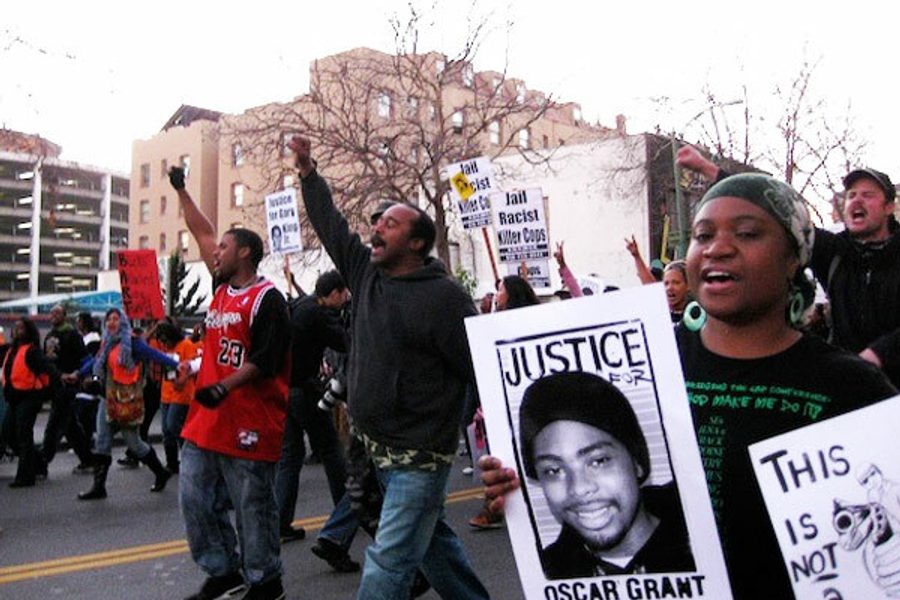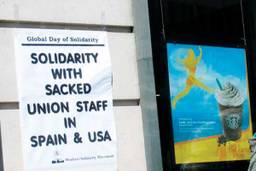To the Streets
The killing of Oscar Grant inspired a Bay Area movement now coming to terms with its own complexity.
Sam Stoker

OAKLAND – For many people in Oakland, 2009 began with the unsettling sound of a gunshot, as Bay Area Rapid Transit (BART) Police Officer Johannes Mehserle fired his Sig-Sauer pistol into the back of Oscar Grant III, killing the twenty-two-year-old unarmed black man as he lay prone on the platform of the Fruitvale BART station in East Oakland.
The shooting, captured on video by multiple onlookers and widely circulated on the Internet, sparked a public response not seen in Oakland in many years. For people whose lives are mired in violence, the shocking videos – along with new footage of BART Officer Tony Pirone punching Grant in the face moments before the shooting – vindicate their calls for systemic level change.
In the wake of Grant’s murder, a grassroots movement has formed around an overwhelming consensus that justice must be served. The incipient movement – comprising activist organizations, artist coalitions, black nationalists, clergy, individuals, liberals, radicals and the poor – has quickly proven itself a formidable force that cannot be dismissed by public institutions.
Yet, at the same time, it seethes with internal debate as it tries to come to terms with its own complexity and competing voices.
The movement now active in Oakland was largely born of rage that, as of early February, culminated on January 7 – the day of Grant’s funeral – after the newly-formed Coalition Against Police Executions (CAPE) called for a protest at the Fruitvale BART station to demand justice for Grant.
CAPE is a coalition of numerous organizations that “came together in response to a call for support from Grant’s family,” said Malachi Garza, a member of both CAPE and the Community Justice Network for Youth. The group has grown quickly, Garza said.
Roughly 500 people congregated at the BART station the evening of January 7 and shut the station down by blocking the entrance, despite an announcement earlier that day that Mehserle, who had been put on paid administrative leave after shooting Grant, had resigned from the police force.
The sentiment of the assembly, which demanded that all officers present when Grant was killed be jailed, was that justice delayed is justice denied. Though some present called for a peaceful resolution to Grant’s death, angry energy permeated the crowd. That anger was perhaps best articulated by Mandingo, chairman of the Bay Area Black Panther Committee [he goes by this name only], when he told the crowd: “I am tired of words and speeches; I am ready for action.”
Soon after, several hundred people chanting “We are all Oscar Grant” and “No justice, no peace” took over the streets of downtown Oakland, thrashed a police car and broke storefront windows after confrontations with the police. The march made national news.
“What happened that night was a clear example of people expressing their rage and loss of faith in this system,” said Rose Braz, campaigns director of Critical Resistance, a prison abolitionist organization.
‘A bunch of criminals’
The “violence” of that night (the mob never targeted or hurt any people) would become a source of contention between factions of the left in the days that followed. Some condemned the property destruction that occurred that night and advocated for peaceful resolutions. But others argued that the demonstration – followed later that same evening by another wave of destruction more impassioned than the first – thrust public outrage over Grant’s murder onto the national stage and forced public institutions to respond to the shooting.
The following day California State Assemblyperson Tom Ammiano and California State Sen. Leland Yee announced intentions to introduce a bill calling for the creation of an independent oversight board for the BART police – a police institution that has had no public accountability since its inception. (The previous night, Oakland Mayor Ron Dellums had stood on the steps of City Hall and announced his initiation of an independent investigation into the BART shooting – only to find himself booed.)
One week later, the day before CAPE’s second mass mobilization on January 14, Alameda County District Attorney Tom Orloff – who himself had been criticized for his failure to press charges against previous Oakland Police Department officers who have killed citizens – charged Mehserle with murder. It was an unprecedented act, and Mehserle, who had fled to Nevada after receiving multiple death threats, was thrown in jail.
In the days that followed, more and more people were drawn into the movement, and in cities across the country the call went out for solidarity mobilizations.
However, divisions within the movement became obvious after January 7. While some CAPE organizers publicly expressed sorrow over that night’s events, a burgeoning leadership of young, revolutionary-minded people of color emerged that night who refused to reject the use of direct action like that of January 7.
The conflict became increasingly evident in the planning of the January 14 mobilization, which would later draw some 2,000 people to Oakland City Hall. In public planning meetings, CAPE leadership took a firm stance that the mobilization would be peaceful and it began coordinating a security force to prevent conflicts with the police.
“The decision by CAPE leadership to push for a peaceful assembly was led by the wishes of Grant’s family,” Garza said. “It was not an attempt to drown the opinions of others or tell them what they should do.”
But radicals within the ranks of CAPE, as well as from organizations outside the coalition, argued the leadership was undermining the movement and condemning those in favor of using any means necessary to get results.
“The leadership of CAPE was trying to turn those calling for action into a bunch of criminals,” said Mandingo, who has been a radical voice inside CAPE from its inception. “I respect the wishes of Grant’s family, but this has grown beyond them.”
‘Ballot or the bullet’ debate
In a January 19 San Francisco Bay View article titled The Smothering of the Oscar Grant Movement, JR, Prisoners of Conscious Committee’s (POCC) Minister of Information and host of the “Block Report” on KPFA FM in Berkeley, wrote: “Who is CAPE really saving, the system or the people?”
The essay criticized CAPE’s insistence on having a peaceful demonstration and for permitting “Mayor Dellums’ criminal ass” to speak at the January 14 rally. “If we were not protesting the mayor at city hall, who were we protesting?” he asked.
The conflict between those advocating a peaceful movement and those arguing for direct action has led to a “ballot or the bullet” debate that has been intensified by allegations that CAPE’s leadership is undemocratic and lacks roots in the communities of people who risked their freedom on the streets January 7.
“These so-called leaders just want to be seen at press conferences, to be in the spotlight, they are not part of the communities they claim to represent” Mandingo said. “None of them have been seen in East Oakland and the Lower Bottoms of West Oakland.”
In response to the situation, on January 23 the POCC organized a “Town Bizness Town Hall Meeting” in West Oakland. The forum’s goal, JR said, was to “give the community an opportunity to speak freely about what happened to Oscar Grant and their feelings on the Oakland Rebellions.”
A meeting was important, JR wrote in a February 5 Bay View article, because
many of the groups…organizing around this issue say that “their demands” are the people’s demands and “their goals” are the people’s goals, yet they have never had an open forum to discuss with the people what the people think in general or about the demands specifically.
Yet, while CAPE does not encompass the entirety of the movement, as a coalition comprising so many different organizations it has, perhaps unwittingly, become a major force in the movement – one that no one involved can ignore.
While Garza, whose opinions are to the left of the generally moderate CAPE, acknowledges that mistakes have been made, she said she thinks there is a tendency to over-romanticize the January 7 uprising.
“I don’t think the rebellion was the sole catalyst of Mehserle’s arrest,” Garza said. “It played a role, but so did the video, the actions of the faith and clergy community, even some elected officials.”
However, Garza added she thinks the debates and critiques are healthy. CAPE is a coalition in the midst of transition that has the potential to create a unified front in the struggle for justice, she said. “What it is right now is unclear,” she said. “But, I’m really interested in what comes from the many voices doing work right now and on this I am clear: whatever CAPE becomes, it will be far larger than me.”
Mandingo, one of the strongest critics of the leadership and decisions made by CAPE, also refuses to ignore the coalition’s potential. “Though there are different agendas and goals, ultimately, we are still coordinating and moving forward.”





